Despite the richness of its biodiversity, Alabama is home to various undiscovered hazards. It harbors some of the world’s deadliest flora, which can cause extensive damage to both humans and animals. Understanding these risky plants can be crucial, whether you are living in the state or planning to travel there, as it could save your life. Continue reading to learn how to identify and safeguard against these poisonous plants found in Alabama.
1. Poison Ivy (Toxicodendron radicans)
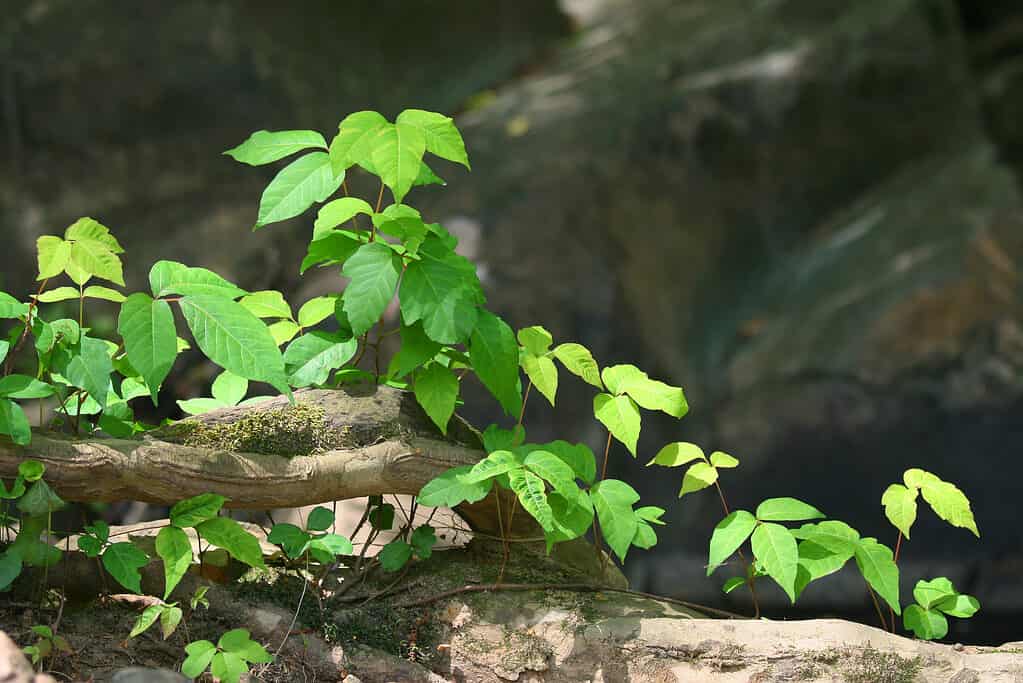
Delicate yet dangerous, poison ivy unveils its vibrant leaves, bearing the potential to inflict skin irritation upon unsuspecting individuals.
©iStock.com/email2ying
Poison ivy is a plant that causes allergic reactions in some individuals who come into contact with it. The plant has three leaves forming a leaflet set in groups of 2-5 along a stem or petiole. These leaves have pointed ends ranging from two to five inches long. In the spring, poison ivy can appear shiny green and waxy. During the late autumn season, the leaves turn red, orange, and yellow, like other trees in the area.
In its natural habitat, poison ivy thrives in marshy or wooded areas. However, it can still grow in places such as roadsides, parking lots, fence posts, landscaping beds, abandoned gardens, stone walls, sawdust, and compost materials where human activity was previously present. Poison ivy’s growth follows animal paths based on deposits they leave behind and on seed dispersal through birds, wind, mammals, and water. Poison ivy especially likes acid soil.
2. Poison Sumac (Toxicodendron vernix)
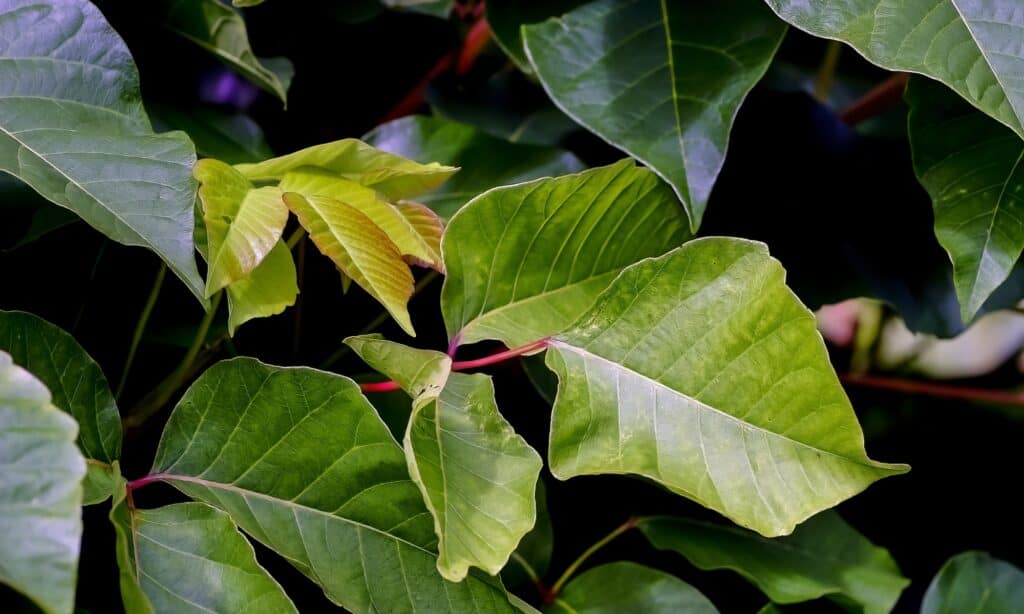
Beware the treacherous beauty of poison sumac, its leaves adorned with clusters of white berries, conceal a potent toxin.
©iStock.com/Werner Meidinger
Poison sumac is a plant that thrives solely in waterlogged or flooded soil, commonly found in peat bogs and swamps. All its components carry oil that irritates the skin, causing intensely itchy rashes and blisters. Breathing in smoke from the burning leaves and vines of a poison sumac is exceptionally dangerous.
The two types of poison sumac (staghorn and smooth sumac) exhibit comparable traits. They possess compound leaves with finely toothed leaflets, ranging from 11 to 31 in number. The red berries of both plants grow in upright clusters above the leaves. Staghorn sumac grows taller, reaching heights of 25 feet and 6 inches or more in diameter. Its fresh twigs bear a resemblance to fuzzy antlers covered in velvet. In contrast, smooth sumac is much smaller, usually reaching a maximum height of 10 feet.
These two common species often grow in clusters of small trees from a single spreading rootstock. It is important to note that neither staghorn nor smooth sumac harms the skin. Poison sumac is rare, and few have encountered it. It contains the same allergenic oil, urushiol, as poison ivy. Urushiol is a strong allergen that can trigger skin reactions such as itchiness and severe blisters.
3. Poison Oak (Toxicodendron pubescens)

Encounter the notorious poison oak, its sprawling vine adorned with unmistakable clusters of three leaves. This seemingly innocuous plant harbors the potential to cause skin irritation upon contact.
©ShutterstockProfessional/Shutterstock.com
Poison oak is a vine or shrub with foliage that blooms in a bright green hue during springtime before taking on a red, slightly brownish-orange color as late summer sets in. This plant is amazingly variable and can be observed as a dense shrub in an open area full of sunlight and climbing up vines in shady spots. Like poison ivy, it spreads through creeping roots or by hatching its seeds. Every leaf comprises three leaflets, each measuring 35 to 100 mm long with scalloped, serrated, or lobed edges.
This plant produces urushiol, a potent allergen that irritates 50-85 percent of those exposed. The range of responses can differ greatly depending on the particular circumstance, with some individuals experiencing only minor inflammation while others may suffer from significant blistering. Although the leaves may have disappeared in winter, the stem remains intact. It poses an even greater risk for skin contact, so safeguarding your legs when hiking and keeping within designated trails are steps to take to stay safe.
Should you get exposed while out and about, desist from touching other parts of your body, and if possible, discard exposed apparel and cleanse thoroughly with an oil-cutting soap. Irritation can be remedied using common calamine lotion treatments, while more intense issues beg attention from medical experts.
4. Oleander (Nerium oleander)
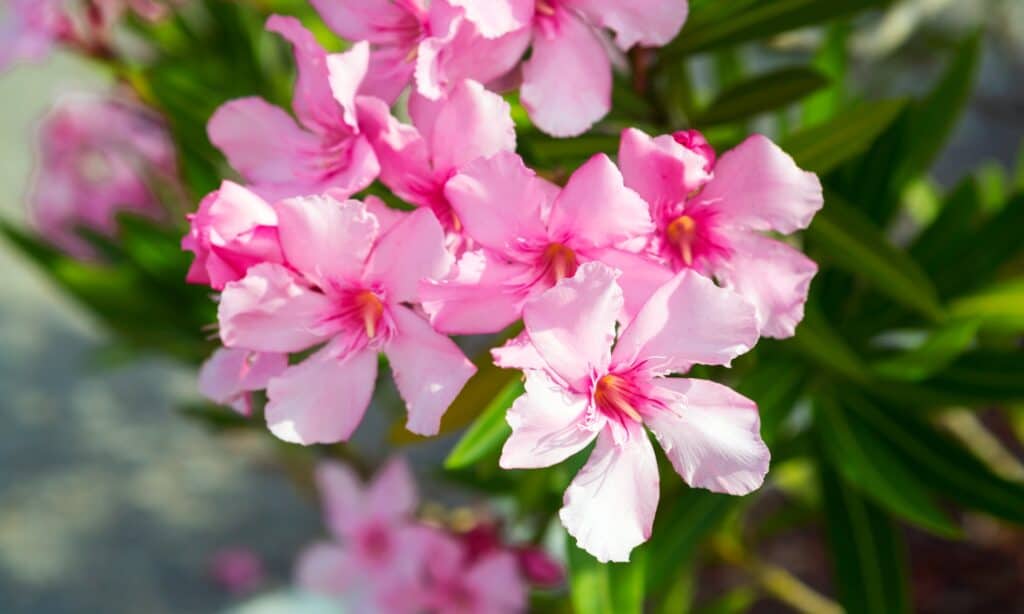
Delight in the vibrant beauty of oleander, as its blossoms burst forth in a captivating display of colors. But beware, for beneath its enchanting facade lies a plant of great toxicity.
©iStock.com/Katrin_Timoff
One of the prominent evergreen shrubs from the dogbane family, Apocynaceae, is the oleander (Nerium oleander). Hailing from the Mediterranean region, this plant stands out with its vertical shrub-like structure and its broad lance-shaped leaves. It occasionally produces clusters of flowers resembling those of the rosebay, appearing in various shades of white, yellow, or rose. Hairy anthers accompany the stigma at the flower’s tip. Eventually, the fruit or seed vessel splits open, releasing numerous seeds adorned with silky tufts.
Pliny the Elder describes the oleander, highlighting its poisonous nature and beautiful rose-like flowers. The Greeks had three names for this plant: rhododendron, nerion, and rhododaphne. Throughout history, the common oleander has been cultivated in greenhouses for an extended period, leading to the development of various other varieties.
Notably, a small variety called the sweet oleander (Nerium indicum) emits a delightful vanilla fragrance from its blooms. In warm countries, oleanders are widely grown outdoors. However, it is crucial to note that the entire plant is highly toxic if ingested; even contact with it can cause skin irritation.
5. Wisteria
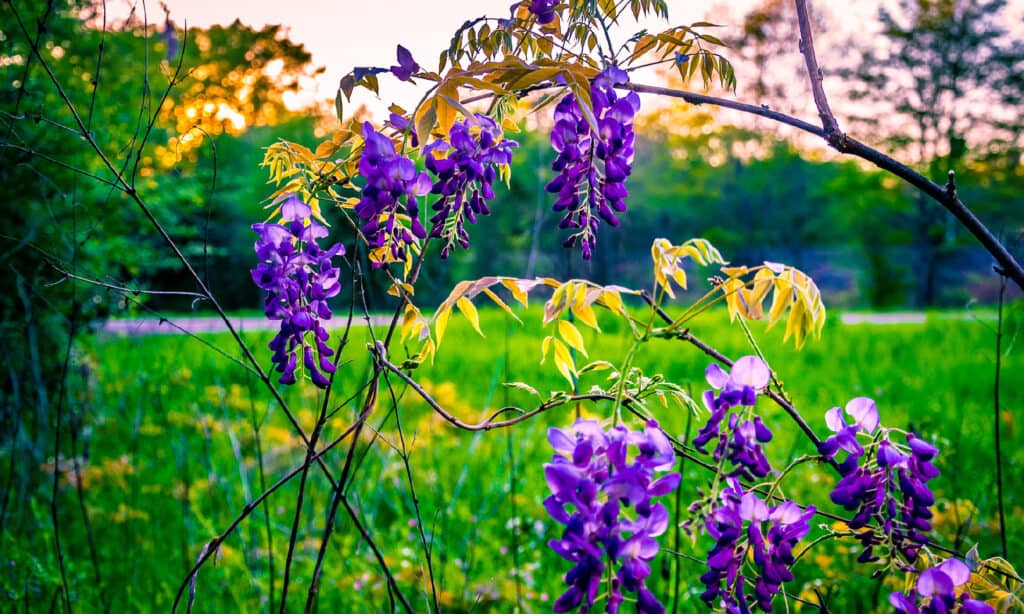
The captivating
Wisteriaflowers. While their beauty is undeniable, it’s important to remember that
Wisteriacontains toxic compounds. Admire their elegance from a safe distance.
©iStock.com/Steve Shubert
The Wisteria plant poses a significant danger, especially its pods, and seeds. Although severe poisonings are rare, even ingesting just two seeds can have devastating consequences. Oral burning, stomach discomfort, diarrhea, and vomiting are all possible symptoms. Gastrointestinal problems may appear approximately 1.5 to 3.5 hours after exposure. There have been cases where individuals experienced:
- Confusion
- Syncope
- Vertigo
- Weakness
- Elevated white blood cell counts
Fortunately, most symptoms tend to diminish within 24 hours. However, there was one reported incident where chronic weakness and vertigo persisted for 5 to 7 days. It’s important to note that lectins’ mitogenic and blood clotting effects have not been observed in cases of hazardous exposure to the plant. Additionally, exposure to smoke resulting from the burning of Wisteria has been associated with headaches.
6. Azaleas (Rhododendron)
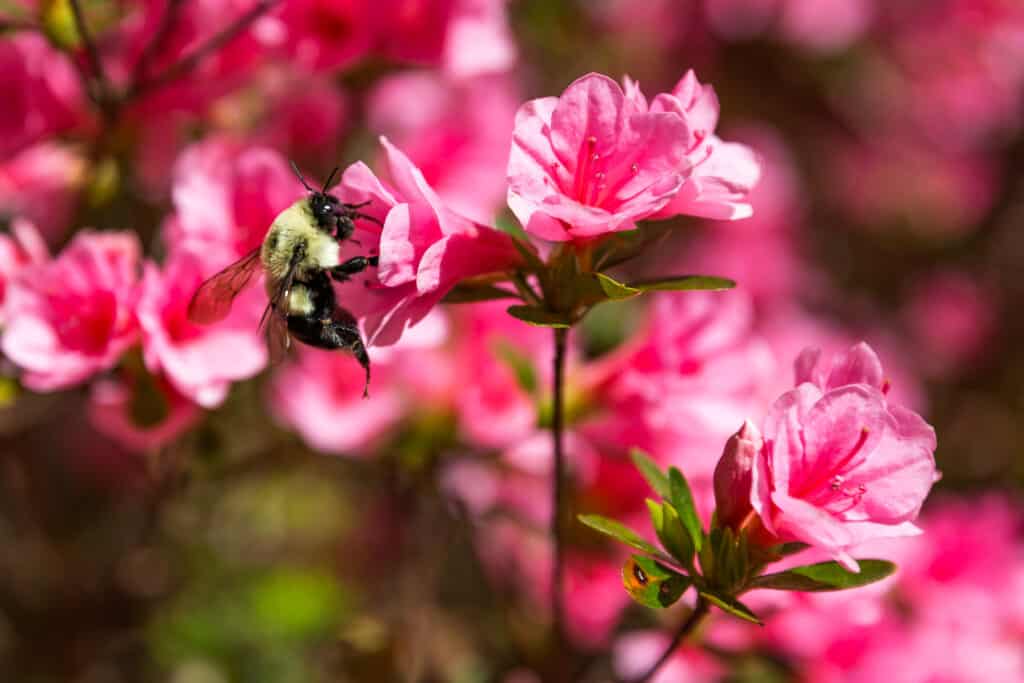
A captivating display of azalea flowers, their vibrant hues enchanting all who behold them. However, beneath their stunning exterior lies a hidden danger, as Azaleas are known to contain a toxic compound.
©Scott F Smith /Shutterstock.com
Most rhododendrons are evergreen, but azaleas tend to shed their leaves in the fall and winter. The azalea flowers possess a funnel-like appearance, with a somewhat double-lipped structure and frequently emitting an aroma. In contrast, the blossoms of Rhododendron plants tend to be shaped like bells more regularly. Compared to the ten or more found in rhododendrons, azalea blooms typically feature about five protruding stamens. There are instances where intermediate forms manifest.
Despite their aesthetic appeal, these plants can pose a significant hazard when consumed by humans and animals. They contain grayanotoxin, a harmful compound that negatively impacts normal functioning of both the digestive and nervous system. Ingesting a significant amount of azaleas may result in symptoms ranging from nausea, vomiting, and diarrhea to unusual heart rate and breathing, paralysis, and possibly fatal outcomes. It’s necessary to be cautious while planting these attractive blooming shrubs in their yards or gardens.
7. Yellow Jessamine (Gelsemium sempervirens)
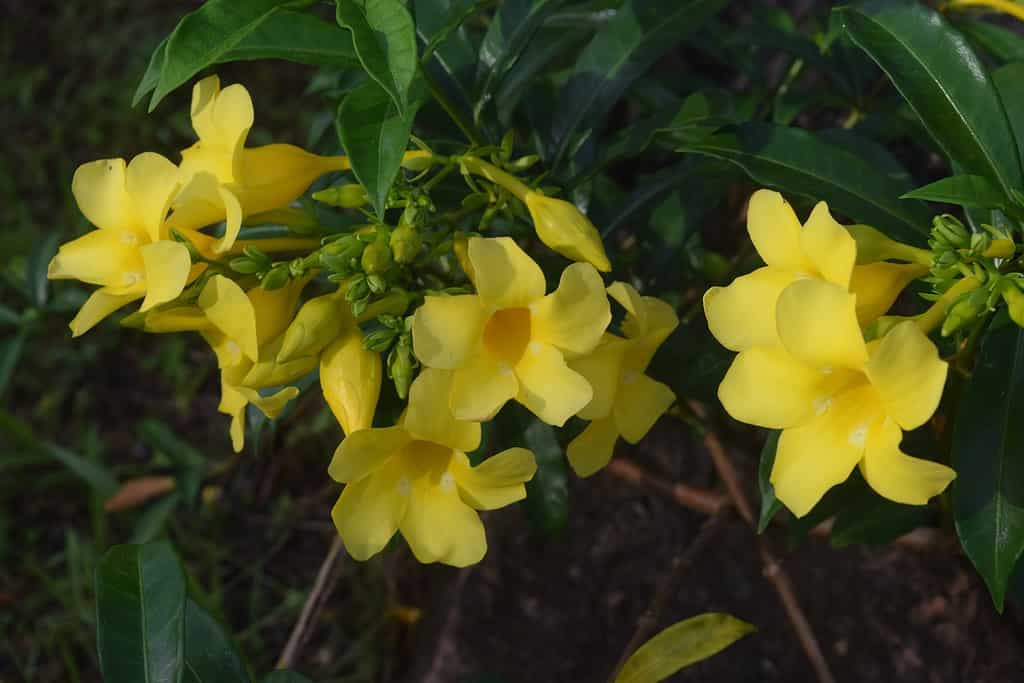
Delight in the radiant charm of yellow jessamine as its sunny yellow blossoms illuminate the landscape. Yet, we must exercise caution, for within this alluring flower lies a potent danger.
©Ayobelajargo/Shutterstock.com
The southeastern areas of the United States is home to a climbing vine known as yellow jessamine. It goes by several monikers, including Carolina jessamine, yellow jasmin, or poor man’s rope. It is commonly referred to as “The Pride of Augusta” owing to its large presence in the surroundings of Augusta, Georgia. The official state flower of South Carolina is the yellow jessamine, which is also featured in the state’s quarter in conjunction with the Carolina wren and cabbage palmetto.
Yellow jessamine stands out due to its attractive display of bright yellow flowers that bloom during late winter or early spring, when few other plants are flowering. The entire plant is highly toxic, particularly to domesticated animals. However, the vibrant yellow flowers that bloom in spring are a vital source of nectar for butterflies. The grazing habits of deer also include browsing this plant for sustenance and fiber.
At a far sight, this plant can be easily mistaken for the intrusive cat’s-claw vine. The leaves on both vines are positioned opposite each other; however, those of the cat’s-claw vine are compound, while those of yellow jessamine are simple. Moreover, the flowering period of the cat’s-claw vine considerably contrasts with that of yellow jessamine, as it blossoms during late spring after the latter’s disappearance. It is unlikely for both vines to bloom simultaneously at a single location.
8. Common Milkweed (Asclepias syriaca)

Common milkweed contains toxic compounds that can be harmful if ingested.
©iStock.com/mr_coffee
Common milkweed belongs to the Asclepiadaceae family and is one of the 115 varieties found in the Americas. The majority of species inhabit either tropical or desert regions. This poisonous plant is derived from the Greek deity Asklepios — the god of healing and medicine. The medicinal properties of certain milkweed species have been documented throughout history, such as common milkweed’s effectiveness in treating warts and lung conditions, as well as butterfly weed’s healing properties.
Milkweed typically grows in groups of sturdy stems and can reach a height of 1.5 meters or 5 feet. It rapidly spreads through its rhizomes, creating large groupings. They have a prominent midrib underneath and are somewhat dense in texture. The upper layer appears in olive to forest green variations, whereas the lower layer is comparatively lighter, occasionally exhibiting a white hue. The milky latex is emitted from broken stems and leaves. The plant typically produces 2-5 groupings of flowers arranged in rounded clusters, known as umbels, at the uppermost point of the structure.
Milkweed plants have high levels of cardiac glycosides, making them poisonous to almost all insects and animals. Some insects use cardiac glycosides as a form of protection. Monarch butterflies employ this defense tactic, deterring birds from interfering with the butterflies and their caterpillars. The northern monarchs, who feed on common milkweed, do not accumulate significant amounts of toxic compounds, making them potentially edible to birds — unbeknownst to them.
9. Daffodil (Narcissus pseudonarcissus)
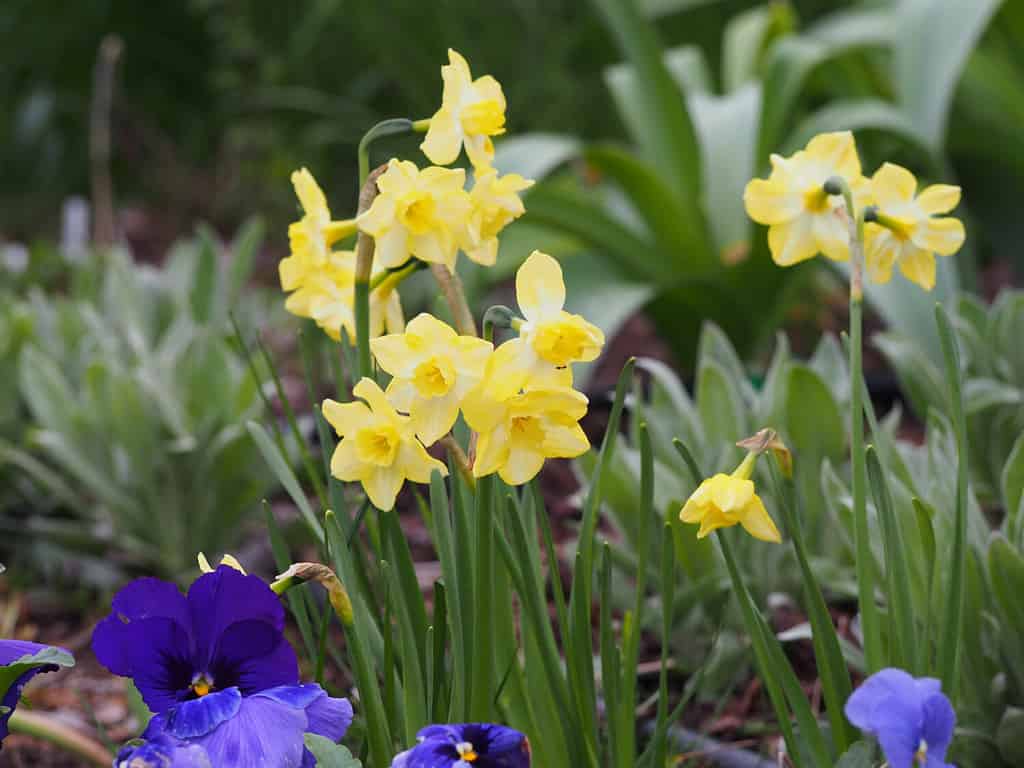
Immerse yourself in the radiant allure of daffodils as their vibrant blossoms announce the arrival of spring. While their charm captivates, it is important to note that certain parts of the daffodil plant contain toxic substances.
©Anna Gratys/Shutterstock.com
The daffodil is highly cherished for its beautiful trumpet-shaped blossoms. Originally hailing from northern Europe, daffodils are cultivated in diverse regions worldwide, thriving in moderate climates. Over time, their immense popularity has led to numerous new daffodil varieties. In addition to the classic yellow hue, the trumpet, and petals can now exhibit a range of colors, including white, pink, and orange.
The daffodil, a resilient plant known for its endurance, stands tall at around 41 cm (16 inches). Its hardy and firm bulbs sprout five to six slender leaves, stretching to about 30 cm (12 inches). The flower’s corolla, divided into six distinct lobes, surrounds a central corona resembling a bell. Delicate frills embellish the corona’s edges, lending an exquisite touch. However, the most captivating feature of the daffodil lies within — a trumpet-shaped structure guarding the stamens, which stands as a testament to its enchanting allure.
Although daffodil is usually recognized for its stunning appearance, it has been discovered to possess certain dangerous characteristics. Consumption of any component of the plant, whether by humans or domestic animals, can lead to serious symptoms due to its toxic nature. Consuming even a small amount can lead to digestive discomfort, including vomiting and diarrhea. Ingesting a larger amount can result in death. Merely contacting certain daffodil sections can cause skin inflammation or intense blister formation.
10. Morefield’s Leather Flower (Clematis morefieldii)
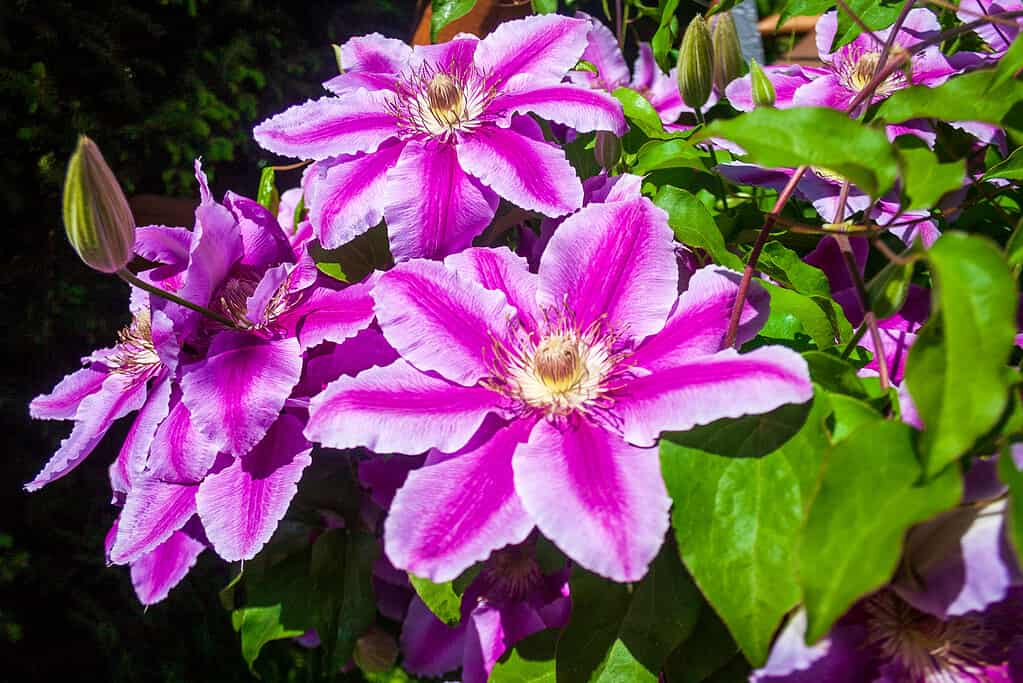
Discover the captivating allure of Morefield’s leather flower (
Clematis morefieldii) as its delicate blooms grace the landscape. However, caution is warranted, for this charming flower harbors potential danger.
©iStock.com/photo_Pawel
The Morefield’s leather flower, a type of vine belonging to the buttercup family, is a perennial plant exclusively found in the northern part of Alabama. The species can be recognized by urn-shaped blossoms that grow alone or in small groups within the leaf joints. Leafy bracts support the main stems of its flowers (peduncles). The shoot is covered with white hairs, and the lower leaf surfaces have a velvety texture.
The vines of this particular species grow in rocky limestone forests on the south and southwest slopes of mountains, taking root in basic clay-loam soils. Typically, plant growth can be characterized by sprawling across boulders or shrubs or by the ability to climb undergrowth shrubs. The Morefield’s leather flower is found in areas close to seepages within a juniper-hardwood community where the smoke tree is the main species serving as an indicator.
The Morefield’s leather flower has a variety of elements that make it somewhat poisonous. Ensure you and your furry companion are secure.
11. Wake Robin (Arum maculatum)

Wake robin (
Arum maculatum) flowers. Appreciate their allure from a safe distance, recognizing the intricate balance between beauty and potential harm.
©iStock.com/Oleg Marchak
The wake robin is a member of the Araceae family. It goes by various common names such as:
- Lord-and-ladies
- Adam-and-Eve
- Cuckoo plant
- Bobbins
- Starch root
Every part of wake robin is poisonous, but the berries hold the greatest amount of toxic substances. It exudes a fragrance that entices flies to enter its sheath. The bright red berries are formed due to the pollination done by the flies.
12. Hortensia (Hydrangea arborescens)

Admire their splendor from a safe distance, appreciating the delicate balance between their beauty and potential harm.
©LifeCollectionPhotography/Shutterstock.com
Hortensia, categorized within the genus Hydrangea, are a group of woody shrubs that grow upright or climb, belonging to the family Hydrangeaceae. There are approximately 23 known types of this species. Many varieties are cultivated indoors and outdoors due to their attractive, typically spherical blossom bunches.
Poisonous Plants in Alabama
Alabama’s rich biodiversity comes with hidden dangers in the form of poisonous plants. Awareness of these hazards is crucial for residents and visitors to the state. These plants demand caution.
Poison ivy, poison sumac, poison oak, oleander, Wisteria, azaleas, yellow jessamine, milkweed, daffodils, leather flower, wake robin, and hortensia all possess varying degrees of toxicity, and ingestion or contact with them can lead to serious health issues. Recognizing these plants and taking necessary precautions can help prevent unfortunate encounters. Exploring Alabama’s natural beauty can be enjoyed safely by staying informed and vigilant about these potentially dangerous plants.
The photo featured at the top of this post is © Victor FlowerFly/Shutterstock.com
Thank you for reading! Have some feedback for us? Contact the AZ Animals editorial team.







